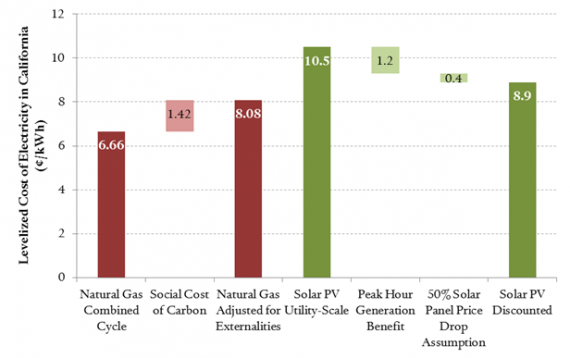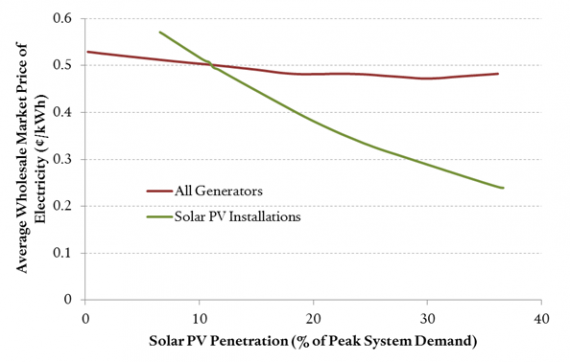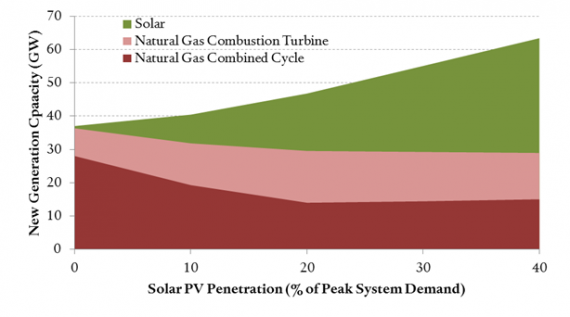The World Needs Post-Silicon Solar Technologies

In his 2007 keynote address to the Materials Research Society, Caltech Professor Nate Lewis surveyed global energy consumption and concluded that out of all the renewable options, only solar power could meaningfully displace human consumption of fossil fuels. However, he warned, the cost of solar would need to fall dramatically to make this possible—Lewis targeted less than a penny per kilowatt-hour (kWh) of energy and dismissed any prospect of existing silicon solar technology meeting that goal.[1] Solar, he argued, “would have to cost not much more than painting a house or buying carpet…Do not think ‘silicon chip,’ think ‘potato chip.’ ”
Very few seem to remember that distinction. Since Professor Lewis’ talk, the price of silicon solar photovoltaic (PV) panels, which account for over 90 percent of the market, has fallen by over 80 percent, and the final installed cost of solar power continues to decline with regularity. If one believes commentators captivated by solar’s heady ascent, a recent solar deal in Dubai, which pegged the price of solar at 6 ¢/kWh, heralds a coming-of-age for solar power, set to displace fossil fuels around the world. Indeed, the Department of Energy’s (DOE) goal by 2020, through the SunShot program, is to bring U.S. solar costs down to the same 6 ¢/kWh mark achieved in Dubai—DOE’s funding strategy therefore concentrates on bringing down the soft costs (permitting, installation, equipment) of solar, implicitly assuming that the underlying solar panel technology is a largely solved issue.
More on:
But last week, my colleague Michael Levi posted a piece on this blog warning that clean energy cost-competitiveness targets are not static if clean energy is to “take a massive share of the market rather than just nip at its fringes.” And earlier this month, “The Future of Solar” report from the MIT Energy Institute presented an excellent rejoinder to advocacy of deployment at the expense of innovation in solar PV energy. Their argument, unpacked below, is that solar panels face a moving target for achieving cost-competitiveness with fossil-fuel based power that becomes more difficult as more solar panels are installed. As a result, even after the expected cost reductions that accompany increased experience with silicon technology, solar PV cannot seriously challenge and replace fossil-fuel generation without advancing beyond the economics of silicon.
Today, unsubsidized silicon solar panels are not cost-competitive with conventional generation in the United States.
To seriously challenge fossil fuels around the world, solar PV must achieve “grid parity,” or a cost that is competitive with other power sources on an unsubsidized basis—the MIT report first seeks to establish that solar in the United States fails this test today. To do so, for each generation option the authors calculate the “levelized cost of electricity” (LCOE), or the cost per kWh of energy produced. By standardizing the costs of different generators, LCOE serves as the traditional method to enable an apples-to-apples comparison of generators with different up-front vs. ongoing cash flows—for example, solar panels cost a lot to install initially but then each kWh of power costs next to nothing to generate, whereas a natural gas plant has some initial costs and also considerable ongoing O&M and fuel costs.
The authors find that a large, utility-scale solar installation is not competitive with a combined-cycle thermal plan—a common natural gas generator—regardless of whether the solar is sited in a sunnier location (they use California and Massachusetts as representative cases of sunny and cloudy climates). Just to stress-test this conclusion, they then tack on a CO2 externality cost to the natural gas plant, and they also discount the solar LCOE to account for a potential 50% reduction in solar panel prices as well as the fact that solar power tends to be generated at more valuable hours of the day and therefore offsets expensive power, resulting in a lower effective cost to the utility. But even with this generous set of assumptions that stacks the calculation in solar’s favor, the LCOE of solar remains higher than that of natural gas in California’s sunny climate (Figure 1).

As the penetration of solar power increases, solar will become less valuable.
Figure 1 may suggest that, under a generous set of assumptions, the cost of silicon solar panels is at least pretty close to that of conventional generation. But the 8 ¢/kWh target is deceptive—as more solar panels are deployed, the cost of solar must drop considerably in order to stay competitive. The reason for this moving target is that the marginal value of one more solar panel on the grid depends on the existing set of generation options already in play. If there are very few solar panels installed, then each new one is actually more valuable than its LCOE might suggest, because solar generates power during periods of high electricity demand—in other words, the utility avoids the cost of dispatching expensive on-demand generators and should therefore discount the LCOE of solar, as displayed in Figure 1.[2]
But if there is already a high penetration of solar power on the grid (e.g., greater than 20% of generated energy), then there is already a surplus of cheap energy supply at times of high demand, because the variable cost of solar power is zero. Now, the situation is reversed—the utility will perceive a higher effective cost of procuring more solar power, and the LCOE will be an underestimate. As a result, in the wholesale market where different generators compete to sell power to the electricity grid, owners of solar panels will face falling prices—revenues to solar owners could fall by over half, because utilities will bid a lower price for solar under double-digit percentage penetration (Figure 2).
More on:

This causes a negative feedback loop—as more solar is developed, the price for solar falls, discouraging further deployment. Moreover, the falling market price for solar only partially represents the full decline in value that solar presents to a utility as solar penetration increases. More solar on the grid actually increases the need for cycling thermal power plants, resulting in accelerated degradation of the equipment and more expensive and inefficient operation. In fact, after a certain penetration, additional energy from solar power does not displace thermal generation at all, since more thermal capacity must be added to compensate for the fact that solar is an intermittent, unpredictable power source. This is evident from Figure 3, which illustrates that beyond a 20 percent solar penetration, new solar does not reduce the requirement for new thermal generation.
One might argue that solar has successfully achieved very high penetrations in countries like Germany—there, solar can compose 80 percent of peak system demand on a sunny day. However, in Germany, owners of solar panels are guaranteed a fixed rate (a “Feed-in Tariff”), so they do not experience the moving target of falling wholesale prices. As a result, other generators face plummeting wholesale prices since solar’s price is fixed, putting severe strain on utilities. In a global context, for solar to really make a dent in electricity production and displace double digit percentages of fossil fuel power, it cannot rely on one-off government policies that shield it from market forces.

In summary, an LCOE comparison may appear to place the cost of solar within striking distance of that of conventional fossil-fuel generation. However, after taking into account market supply and demand dynamics and the inferior generating characteristics of solar, the marginal value of solar will fall with increasing deployment. Even if the cost of silicon solar panels drops by 50% in the future and improved experience drives down the total installation costs, halved wholesale solar prices and increased strain on other generators will incentivize neither solar developers nor utilities to push penetration further.
Storage is not a magic bullet that will make the economics of silicon solar panels work.
Some commentators point to the rapidly falling costs of batteries as a sign that in the future, cheap energy storage will neutralize the downsides of intermittent solar generation—by enabling solar installations to store and sell power when valuable to the grid, storage could stabilize the moving target for solar cost-competitiveness.
Indeed, storage does improve the economics of solar at high penetration—but not enough to stabilize the moving target. Evidence for this conclusion comes from a 2013 paper by Hirth simulating the German electricity system—the MIT report drew inspiration from this paper to conclude that the value of solar drops with increasing penetration. Hirth studies the effect of pumped hydro storage on the economics of solar at high penetration and finds that by using storage to shift the time of day that solar installations sell back their energy to the wholesale market, the market’s discount on the value of solar drops. However, that discount does not drop very much, and even after doubling the amount of storage capacity in Germany, owners of solar panels would still face declining wholesale prices with increasing penetration (Figure 4).[3]

New technologies are necessary for solar to compete—and promising candidates exist
The MIT report concludes that “beyond modest levels of penetration and absent substantial government support or a carbon policy that favors renewables, contemporary solar technologies remain too expensive for large-scale deployment…[large] cost reductions may be achieved through the development of novel, inherently less costly PV technologies, some of which are now only in the research stage.”
There is plenty of material in the report assessing emerging, promising technologies. But for the impatient, here’s a teaser: the picture at the top of this post is of a PV coating with fundamental economics not too different from carpets or wall paint. Watch this space for a closer look at the technology and why a solar revolution, though difficult, may not be impossible.
Footnotes
[1] The target of <1 ¢/kWh is my conversion of Prof. Lewis’ cost target of “$10/m2” for solar power. Assuming solar efficiency somewhere between 15–50 percent turns that cost target into 2–7 ¢/Wp (between one and two orders of magnitude below current costs) and an LCOE of well below 1 ¢/kWh.
[2] The MIT report leverages the concept of “Value Factors,” (VF) derived from Hirth, to assess the value of a generator from its generation profile. In essence, the value factor weights the power production profile by the wholesale price at the time of production to determine if the generator on average produces more or less valuable power (VF > 1 and < 1, respectively) than the average wholesale price. Then, by dividing the LCOE by the VF, one can determine an adjusted cost that better represents the utility’s valuation of the generation source (although this still does not take into account dispatchability and dependable capacity). The MIT report finds VF values in the vicinity of 1.1–1.2. The VF concept is closely linked to EIA’s “Levelized Avoided Cost of Energy” (LACE).
[3] Note that Figure 4 measures solar penetration differently from Figures 1–3. Figure 4 uses the amount of energy generated by solar (units of kWh) compared to the total system consumption to calculate penetration—this enables a sensible comparison with the amount of storage (ten percent of system consumption) considered in the simulation. Figures 1–3 use the power capacity of solar generation (units of kW) compared with the peak system demand to measure penetration. In the German example explored in Figure 4, five percent penetration in kWh corresponds to roughly fifty percent penetration by kW—note that the relationship does not scale linearly.
 Online Store
Online Store